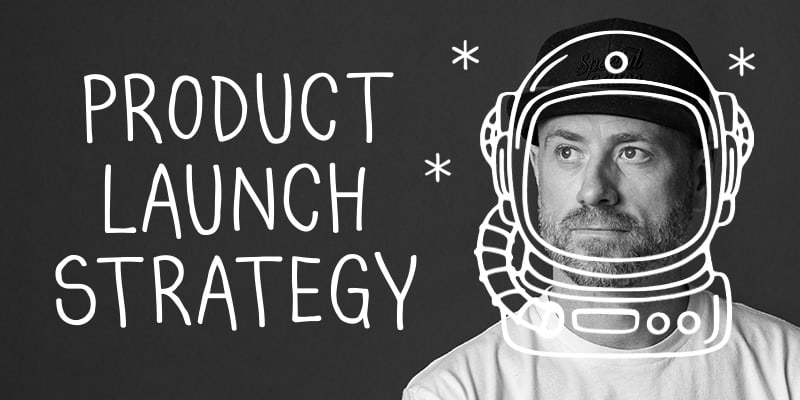
Launching a new product is exciting and scary at the same time. You have a great idea, but it’s easy to get overwhelmed by everything that has to be done to turn your idea into a reality. None of us are immune to launch stress. New companies putting their first product into the world often get paralyzed by indecision, but so do established businesses launching into a new product category.
I’ve worked with hundreds of businesses launching physical products, SaaS products, and services throughout my career. I wish I could say every launch was a raging success, but they weren’t. Some products were complete failures. Although they weren’t my companies (well, a couple were), I did learn four important lessons from these failures.
- Creating a product nobody wants is easier to do than you realize.
- Not building your product for a specific group of people is a death sentence.
- Competition isn’t bad, but failing to differentiate is.
- Know where and how you’ll get customers before you launch.
Looking back, the winners I’ve worked with got these four points right. They had a product people wanted or needed, they understood who their buyer was, they found holes in the competition to exploit, and they knew where to connect with the buyers they wanted without wasting time and money to figure it out after they launched. I’ve since built a simple go-to-market strategy to translate these realizations into a usable framework anyone can follow.
Start By Painting A Picture of What You’re Building
Most entrepreneurs have a great idea and they just go. The excitement takes hold of us and we can’t help ourselves. It’s in our nature to move and move fast. Slow down a little and take a few minutes to make sure you’re pointed in the right direction before you start running.
Answering these five questions won’t guarantee success, but they certainly improve your odds. I can honestly say that these have been transformational for some of our clients. Make sure you’ve got a firm answer for each question before you move on to the next. If you do so, you’ll walk away from this article with a solid foundation for your product launch.
- What problem does your product solve (or what desire does it fulfill)?
Every product must do one of these two things to be viable. This is often called product-market fit if you want a fancy term to impress your VC friends. If you can’t answer this question, you don’t have a legitimate product. Your company will fail if it isn’t a killer solution to a problem or a wonderful answer to a craving.
- Who’s your customer?
Know who has the problem you solve because that’s who is going to buy your product. Your business exists to help these people. Call them your ideal customer (ICP) or target customer if you want. The key is to zero in on a specific group of people who will happily pay for your product. Paint a picture of how these people are like each other and different from everyone else.
- What holes can you find in the competition?
Who else is solving the problem your product solves? Who are you competing with for buyers? What do these people do well? Who is their customer? What don’t they do well? Who are they neglecting? Knowing your competition allows you to find holes to exploit. Figure out how all of the competition is similar so you can be an option that’s fresh and different. Different is good.
- Where (and how) will people buy?
This seems stupid to answer, but it’s not. Know where you’re going to sell your things because that plays a key role in your launch strategy. Make this part of your competitive analysis. If all of your competitors sell through traditional retail, consider going direct to consumer (D2C). The same goes for software and services. Look at where and how everyone else sells and offer a different experience. Where and how you sell can be a competitive advantage and it affects how you position and sell your product.
- How will you make customers aware your product exists?
It’s shocking how many companies launch and then blow through money to try and find customers. Decide where you’ll connect with customers to make them aware your product exists before you launch the product, not after. This is an often skipped step that can be incredibly costly.
The Next Step Is Differentiating
You’ve got a clear idea of what you’re building thanks to the questions above. Now you need to figure out how you’re going to create a tribe of folks who are loyal to your brand and buy it repeatedly. This requires being something better or different from the competition in a way that matters to the people you want to buy. I call this creating your Category of One. There are four common paths companies follow to establish this separation from the competition. These certainly aren’t the only paths to creating a category, but they’re the most common. All of these stem from the idea of leaning into the area of your go-to-market strategy where you have a competitive advantage.
Option 1: Own a problem
You’re so good at solving a problem you become synonymous with the solution. Kleenex is a perfect example of owning a problem. We don’t ask for a tissue, we say we need a Kleenex when we have a cold. This technique can happen on a much smaller scale as well. Find a problem you can solve for someone and do that one thing really well.
Option 2: Fulfill a neglected desire
You find a hidden opportunity in a big market. White Claw is one of my favorite examples here. Canned alcoholic beverages have been around for a long time, but it only took a few years for hard seltzers to explode onto the scene. A huge part of that growth was due to White Claw’s foresight and pioneering. They gave people a low-calorie option that tastes good and doesn’t look ridiculous in your hand. They read the rise of seltzers and jumped on the opportunity to bring that demand to the alcoholic beverage space.
Option 3: Be the local option
You’re the local hometown hero fighting the evil mega-corporations. People love a local option. This strategy has been in use for over a century and it still works. You can ride local fans to 7 or 8 figures of revenue before you need to pivot to a new non-local approach. At that point, you’ll have a base to make the leap. This works for cpg, services, and luxury products.
Option 4: Find a unique sales channel
You use your distribution location as a differentiator. I think this is an underutilized strategy. Hippeas did this brilliantly with Starbucks. You didn’t see Hippeas anywhere but Starbucks at first, but you saw them in every Starbucks. That one channel drove awareness, trial, and eventually further distribution into other channels. RedBull did the same thing with bars and events. They may be synonymous with action sports now, but they drove mass trial by being at every bar and event possible in the early 2000s. There’s so much opportunity to get creative with distribution.
Make It All Work With Execution
Ruthless execution of a mediocre plan beats poor execution of a killer plan. Have a plan and set yourself up for success, but don’t neglect the doing part. The only guarantee is that you won’t get everything right in your product launch strategy, but you won’t know which parts you got wrong until you start executing. Research, plan, execute, adapt, and execute some more.
Working to build a brand? Grab The Recipe and I’ll send you my best branding and marketing tips every Friday.
